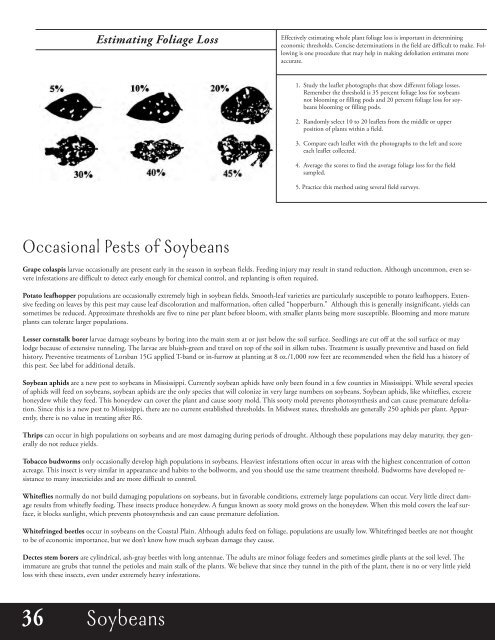Agronomic Crops
mJyPrJ
mJyPrJ
You also want an ePaper? Increase the reach of your titles
YUMPU automatically turns print PDFs into web optimized ePapers that Google loves.
Estimating Foliage Loss<br />
Effectively estimating whole plant foliage loss is important in determining<br />
economic thresholds. Concise determinations in the field are difficult to make. Following<br />
is one procedure that may help in making defoliation estimates more<br />
accurate.<br />
1. Study the leaflet photographs that show different foliage losses.<br />
Remember the threshold is 35 percent foliage loss for soybeans<br />
not blooming or filling pods and 20 percent foliage loss for soybeans<br />
blooming or filling pods.<br />
2. Randomly select 10 to 20 leaflets from the middle or upper<br />
position of plants within a field.<br />
3. Compare each leaflet with the photographs to the left and score<br />
each leaflet collected.<br />
4. Average the scores to find the average foliage loss for the field<br />
sampled.<br />
5. Practice this method using several field surveys.<br />
Occasional Pests of Soybeans<br />
Grape colaspis larvae occasionally are present early in the season in soybean fields. Feeding injury may result in stand reduction. Although uncommon, even severe<br />
infestations are difficult to detect early enough for chemical control, and replanting is often required.<br />
Potato leafhopper populations are occasionally extremely high in soybean fields. Smooth-leaf varieties are particularly susceptible to potato leafhoppers. Extensive<br />
feeding on leaves by this pest may cause leaf discoloration and malformation, often called “hopperburn.” Although this is generally insignificant, yields can<br />
sometimes be reduced. Approximate thresholds are five to nine per plant before bloom, with smaller plants being more susceptible. Blooming and more mature<br />
plants can tolerate larger populations.<br />
Lesser cornstalk borer larvae damage soybeans by boring into the main stem at or just below the soil surface. Seedlings are cut off at the soil surface or may<br />
lodge because of extensive tunneling. The larvae are bluish-green and travel on top of the soil in silken tubes. Treatment is usually preventive and based on field<br />
history. Preventive treatments of Lorsban 15G applied T-band or in-furrow at planting at 8 oz./1,000 row feet are recommended when the field has a history of<br />
this pest. See label for additional details.<br />
soybean aphids are a new pest to soybeans in Mississippi. Currently soybean aphids have only been found in a few counties in Mississippi. While several species<br />
of aphids will feed on soybeans, soybean aphids are the only species that will colonize in very large numbers on soybeans. Soybean aphids, like whiteflies, excrete<br />
honeydew while they feed. This honeydew can cover the plant and cause sooty mold. This sooty mold prevents photosynthesis and can cause premature defoliation.<br />
Since this is a new pest to Mississippi, there are no current established thresholds. In Midwest states, thresholds are generally 250 aphids per plant. Apparently,<br />
there is no value in treating after R6.<br />
thrips can occur in high populations on soybeans and are most damaging during periods of drought. Although these populations may delay maturity, they generally<br />
do not reduce yields.<br />
tobacco budworms only occasionally develop high populations in soybeans. Heaviest infestations often occur in areas with the highest concentration of cotton<br />
acreage. This insect is very similar in appearance and habits to the bollworm, and you should use the same treatment threshold. Budworms have developed resistance<br />
to many insecticides and are more difficult to control.<br />
Whiteflies normally do not build damaging populations on soybeans, but in favorable conditions, extremely large populations can occur. Very little direct damage<br />
results from whitefly feeding. These insects produce honeydew. A fungus known as sooty mold grows on the honeydew. When this mold covers the leaf surface,<br />
it blocks sunlight, which prevents photosynthesis and can cause premature defoliation.<br />
Whitefringed beetles occur in soybeans on the Coastal Plain. Although adults feed on foliage, populations are usually low. Whitefringed beetles are not thought<br />
to be of economic importance, but we don’t know how much soybean damage they cause.<br />
Dectes stem borers are cylindrical, ash-gray beetles with long antennae. The adults are minor foliage feeders and sometimes girdle plants at the soil level. The<br />
immature are grubs that tunnel the petioles and main stalk of the plants. We believe that since they tunnel in the pith of the plant, there is no or very little yield<br />
loss with these insects, even under extremely heavy infestations.<br />
36 Soybeans


